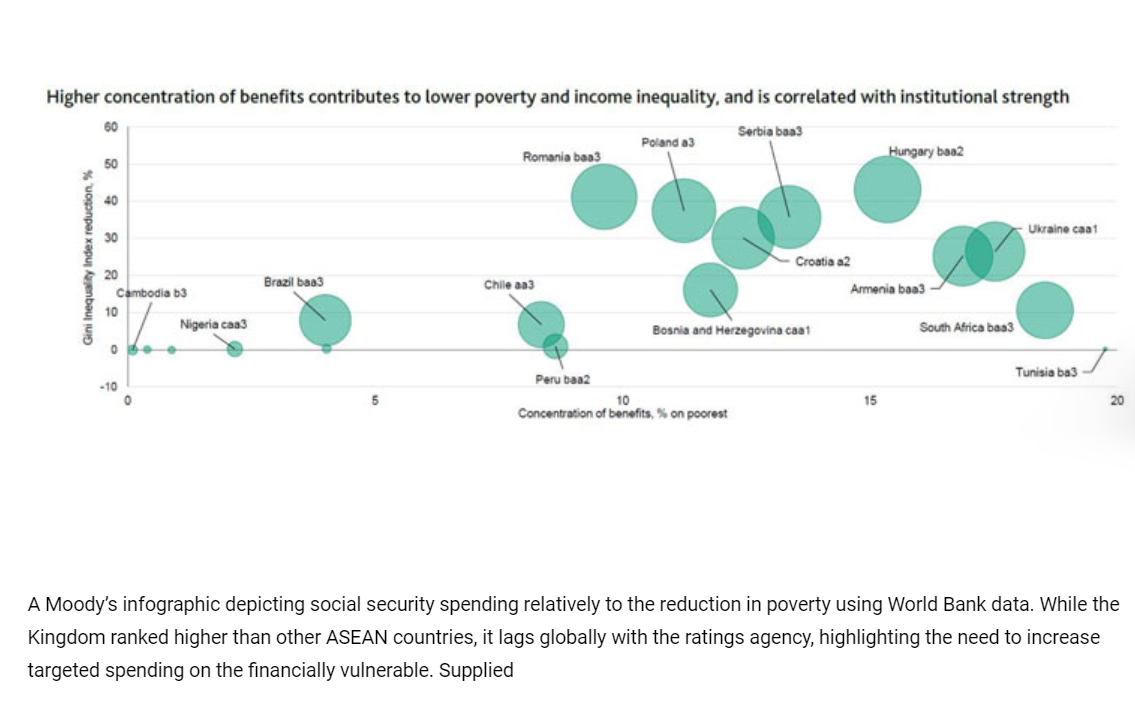Cambodia: Kingdom tops ASEAN in social security spending
Spending only 1.4 percent of its gross domestic product (GDP) on a social safety net, Cambodia outranks ASEAN contemporaries in its relief to financially vulnerable people during the pandemic but continues to lag globally, Moody’s Investor Service reported yesterday.
Moody’s placed Cambodia in “Group 2” (the second best) out of five tiers ranking social safety nets in frontier markets. The Kingdom shared the distinction with Chile, Bosnia and Mauritius.
“Relatively high safety net spending, but programmes do not target lower-income groups leading to weaker poverty and income inequality reduction,” Moody’s said in its definition of the “Group 2” nations.
Indonesia and Vietnam were placed in “Group 3”. Thailand and Malaysia are in “Group 4”. The Philippines and Lao were placed dead last in “Group 5”.
Singapore and Brunei were not assessed.
The Kingdom has spent more than $335 million in relief to its Covid-19 Cash Transfer Programme (CCTP). The initiative is up for renewal on June 25 and is expected to continue for at least another three-month period, according to a source familiar with the matter.
“We [the government] are at a crossroads about whether we should continue with providing direct aid or targeting industries like the garment sector,” the source said under the condition of anonymity.
“We have eradicated extreme poverty and the Prime Minister has no intention of turning back and letting people suffer more than [they] already [are], so it will probably continue, but nothing is certain until he signs the document certainly,” he added.
Khmer Times previously reported that the CCTP was designed to help prevent the neediest to fall into extreme poverty and keep the economic engine at a bare minimum.
More than 2.7 million people or 14 percent of the Cambodian population has received direct aid during the pandemic from the government. A total of 3.1 percent of the labour market was covered by the nation’s social security networks, according to Moody’s.
The source said that the low coverage could be attributed to the high number of Cambodians working in the informal economy.
Officials previously told Khmer Times that the CCTP was designed to benefit the differently abled or those living with chronic diseases.
Additional measures have also been introduced to provide relief, such as those facing loss in income from the tourism industry.
However, despite the government’s targeted strategy, Moody’s found that Cambodia had high spending on social security but low concentration among the most vulnerable.
“Countries with lower spending may fare better in terms of concentration of spending on the poor segment, but with low impact in terms of reduction in poverty and income equality because of the limited reach of social spending given the level of benefit,” the report read.
As expected, countries with higher institutional and governance strength were able to deploy more support compared to those with lower institutional strength, according to Moody’s.
“Safety net programs support governments’ abilities to reach vulnerable groups during times of stress. To be most effective, the distribution of benefits needs to combine both adequate coverage and target spending towards the more vulnerable population,” said Samar Maziad, vice president for Moody’s.
He added, “Generally, higher safety net spending is correlated with stronger outcomes in reducing poverty, while higher concentration of spending towards lower-income households is correlated with decreasing income inequality.”
Safety net coverage was highest in Latin American frontier countries where cash transfer programmes were most prevalent.
The Asia Pacific region ranked just above Sub-Saharan Africa, which was the lowest-ranked region.
Source: https://www.khmertimeskh.com/50874229/kingdom-tops-asean-in-social-security-spending/


 English
English




